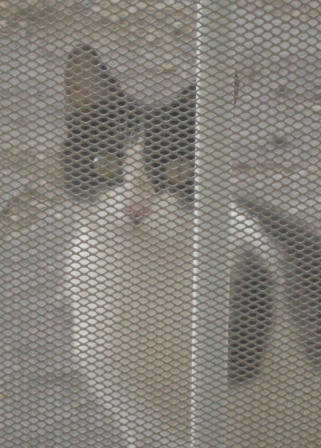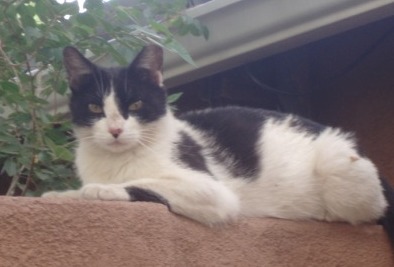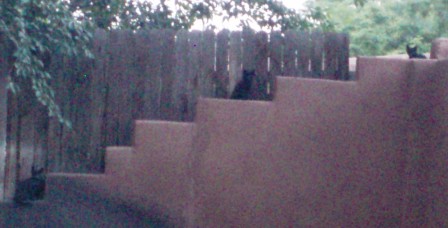
By Liliane McCarthy
NOT ALL FRIENDSHIPS are meant to last forever. That’s the way it was with Suzette. I knew her for just a few months, but I’ll never forget her.
A small black and white cat, she appeared one spring night, clinging to my screen door, desperate. I got up from the dining room table where I had been grading papers, and she took off . I poured some dry cat food onto one of the flagstones outside the door and forgot about her.
The next evening, she appeared again, this time gazing at me from the top of the adobe wall around the backyard. I again poured her some food, and she approached hesitantly after I had backed off , and ate ravenously. Obviously feral, she was the skinniest little thing I had ever seen. Every day she let me get closer. The first time I touched her, she hissed. But after a week or so, she seemed to realize that human touch could be a pleasure. Eventually she was rearing up into my hand to be stroked.
I began putting out water and feeding her three times a day. She was usually perched on the wall, waiting for me. She would gobble the food, hang out for a while, then disappear. This went on for weeks, but I noticed that she was not gaining weight, and I wondered if she was sick. Then one day when I moved in closer to take her picture, I saw that she was a nursing mama. She had been giving all her resources and reserves to her kittens. I started feeding her canned cat food as well.
One morning I decided to follow her to see where she had hidden the kittens. I didn’t want to spook her, so I tried to keep some distance between us. She walked along the road, disappearing momentarily into neighboring yards, taking her own shortcuts and cat paths. Like a detective tailing a suspect, I was able to follow her to a secluded area about 300 yards from my house in Corrales. I could see her lying next to a woodpile. Soon they emerged—one gray and two pure black kittens—greeting their mama and frisking in and out of the woodpile.

I started thinking about what I could do to help this cat and her
babies. I had been renting a casita and had just bought a house in the
South Valley, and would be moving soon. Should I adopt Suzette, as I had
begun to call her? What about the kittens? I already had a cat, and
Suzette had been quite aggressive toward Twilight, who had pounced on
her twitching tail.
And then there was the issue of health. I could not imagine taking
Suzette to the vet. Picking her up was out of the question, let alone
putting her in a carrier. I had tried putting my hand behind her front
legs and lifting her slightly for a second or two, every day a little
longer. I thought we were making progress, until one day I put my other
hand under her hind legs and got my arm shredded as a result.
But I continued to entertain the idea of adopting her, because what
would happen to her otherwise? And what about the kittens? I began
making some phone calls to animal rescue groups, and got a bunch of
advice about feral cats. They do not adapt well to a life “in
captivity.” They are extremely attached to their territory and will try
to find their way back. It’s impossible to truly tame them, and the
kittens were already too old for it. Many adoptable cats and kittens in
shelters are euthanized every day.
I was told that the kindest thing I could do for Suzette was to have
her neutered and release her. With help from New Mexico Animal Friends, I
set a trap, with the idea of taking Suzette to the feral cat neutering
clinic at Animal Humane.
I ENDED UP CATCHING another cat instead. I took him in to Animal
Humane, where the clinic also gives vaccinations and veterinary care—all
for free. They clip the tip of one ear to indicate the animal has been
neutered. The next morning, as instructed, I released the cat. He took
off like a rocket when I opened the carrier door, leaped onto the wall,
gave me a backward glance, then jumped. I never saw him again.
The next evening, I succeeded in trapping Suzette. I felt like a
traitor as I listened to her yowl and bang against the door of the trap
all night. I spoke to her in a soothing voice, hoping that she would
understand. Early in the morning, I drove to Animal Humane again while
she cowered. When I picked her up that afternoon, the staff told me that
she was about 1½ years old and healthy, though thin and dehydrated.
I expected Suzette to shoot out of the carrier the next morning, but
she stuck around expecting to be fed, and reared into my hand to be
petted. I was starting to think she may have been someone’s pet early in
her life. Eventually she sashayed down the road toward her kittens.
Now that I was on a roll with the trap-neuter-release program, I caught
two more cats before I moved. While I felt good about doing a community
service, it was a little difficult knowing that these animals were
terrified throughout the experience. The tortoise shell female I caught
looked deranged with fear when I released her. Both cats tore out of the
carrier and disappeared— but always with the backward glance, which I
choose to believe was a catlike “thank you.” They would not have litter
after litter to sustain.
I’ve always thought of myself as an animal-lover, but this was the
first time I had gone out of my way to help animals that were not my
own. My heart had connected to a small, starving feline trying to keep
her kittens alive, and because of her, to other feral cats as well.

The evening before I moved, Suzette brought her kittens to me. I saw
the sharp silhouette of their ears against the sunset as they sat on the
stair-step corner of the adobe wall. Suzette came to eat in her usual
place, then turned around and meowed to them. They would not approach.
She went to get them, and one of the black kittens followed her a little
way. I could see that they were still nursing, and that she was a good
mama, doing her best in difficult circumstances. As evening fell, the
kittens played in a far corner of the grassy yard. I could just make out
their dark shapes as they chased each other around and jumped on and
off the wall.
In some ways I wished that I could stay and look after them all, trap
and neuter and tame the kittens. I thought again about taking Suzette
with me, but the kittens still needed her. And I knew that she would not
be happy confined indoors. As hard as her life was in Corrales, Suzette
was free—to stay with her kittens, to hunt, to find another human
friend, to sashay down the road, her tail floating behind her like a
feather boa. I was happy to leave her in the care of St. Francis, with
the hope that she would befriend others, as she did me.
Liliane
McCarthy teaches English as a Second Language at Ernie Pyle Middle
School in Albuquerque’s South Valley. She has been befriended by another
formerly feral feline since this essay was written, and enjoys riding
her Arabian horse, Tirnanog (aka Babycakes), in the bosque year round.
